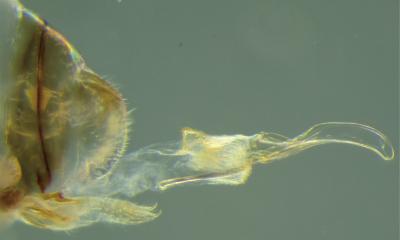Separating two partners having sex is generally a bad idea. It is, after all, something few of us humans would appreciate. But when entomologist Kazunori Yoshizawa of Hokkaido University in Japan caught a pair of newly discovered cave insects in flagrante delicto, he pulled them apart. You know, for science. When he gave their tiny, translucent bodies a tug, he found the penis was so firmly embedded in the other insect that it ripped off its partner’s abdomen rather than dislodge.
An impressive penis, no doubt. But these things happen in insect sex. What made this penis a member of a special club, however, was the fact that it wasn’t on the male. Instead, Yoshizawa had discovered a new species of insect in which the penis belonged to the female and the male had a vagina. Thus far, this is the only species with this arrangement of genitalia yet discovered.
The insects, of the genus Neotrogla, were discovered several years ago in a Brazilian cave by biologist Rodrigo Ferreira at the Federal University of Lavras in Brazil. He’s a specialist in cave ecosystems rather than insects, so he sent them to entomologist Charles Lienhard in Geneva, Switzerland, for more detailed study. It was Lienhard who first discovered the penis on the female. They had to invent a new name for such a thing, and they called it a gynosome.
The insect kingdom has plenty of examples of sex-role reversal in which males provide the majority of investment into protection of the offspring. In some insect species, the male will give the female a gift of nutritious food before copulation, which helps to offset the energy required by the female to produce the eggs. It’s the six-legged equivalent of dinner and a movie. In sex-role reversed species, such as dance flies (Diptera) and scorpion flies (Mecoptera), the female provides the nuptial gift to the male, as he is the one providing the most time and energy to future offspring after the eggs are laid.
This reversal has strange effects on the evolutionary pressures on sex organs. In species with typical sex roles, males produce large numbers of small gametes, giving them the opportunity to produce more offspring than a female can. This means that males are in competition for a scarce resource (females), and the power of sexual selection is stronger on males, which contributes to the strange variety of male genitalia. Female sexual organs tend to be much more homogenous.
In the newly discovered Neotrogla, however, the females use the gynosome to receive a nutritious sperm-containing fluid from the male’s vagina-like opening. The gynosome is first inserted while flaccid and then becomes erect. This erection anchors the spines on the outside of the gynosome into the male.
These spines also enable the female to forcibly copulate with the male. Once inside, the gynosome would cause severe damage if the male pulled away too early (or if an inconsiderate entomologist did it for him). Instead, the authors detail in a study published today in Current Biology, the female controls the entire 40- to 70-hour mating process. In an email, Yoshizawa called the gynosome the “ultimate device for controlling copulation.”
Forced copulation isn’t just a way for the females to spread their genes. In the resource-poor environments of caves, food can be hard to come by, which makes the nutritious semen from males that much more valuable. This increases the pressure on females to mate early and mate often. Although the males benefit by producing offspring, they also have to pay the cost of producing nutrients for the female, which may make them less likely to seek out sexual partners. Thus, the gynosome is a way for the female to obtain not just sex but also dinner.
It’s the first clear example of the female possessing the intromittent organ instead of the male, the authors say, and Neotrogla is the only genus known to possess a gynosome. The authors note in the paper that other species have vaguely similar organs. The females of astigmatan mites, Yoshizawa notes, have a long genital tube that they use to receive sperm, and female scirtid beetles have a genital duct that can be turned inside out. In both of these examples, the male genitalia is significantly smaller than in similar species. The difference between these arrangements and the gynosome is that the gynosome can anchor itself to the inside of the male, whereas the other organs can’t.
Scientists have barely scratched the surface of the strange array of sexual behaviors in the animal kingdom, and the insects where females have a penis can help answer some crucial questions about sexual selection. First, however, the scientists need to figure out how to grow Neotrogla in the lab, which means not prying the amorous couples apart during mating and instead letting nature take its course.
